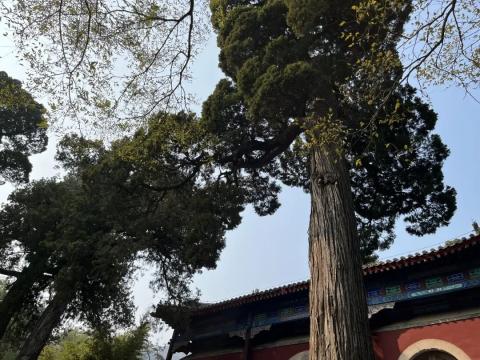
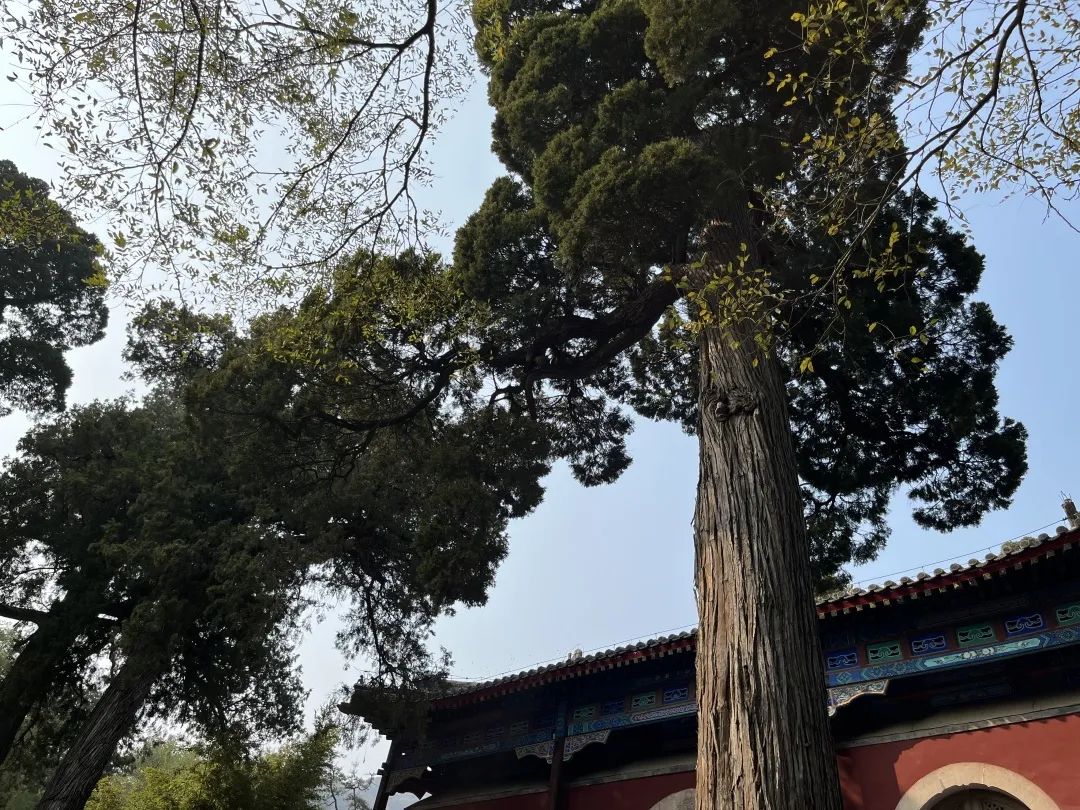
When I climbed Xiangshan Mountain before, I saw several white pagodas in the mist of the mountains and forests from a distance. A friend next to me said that it was the Biyun Temple where Dr. Sun Yat-sen once laid his tomb. I am not very keen on admiring the great heroes and heroes, and I think that I have to climb up to the top of Xiangshan Mountain to get there, so I have never visited Biyun Temple.
Recently I have read some books about the three mountains and five gardens in Beijing, and the description of Biyun Temple Shuiquanyuan moved me quite a bit. Coupled with the excitement of autumn colors, Biyun Temple is naturally included in the list of must-visit destinations for autumn appreciation.
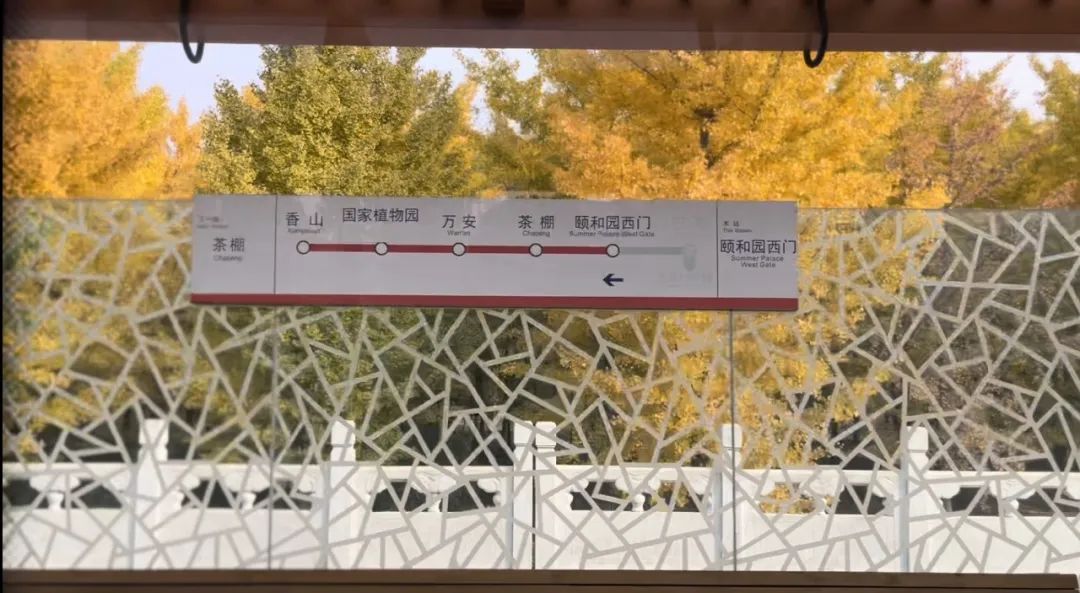
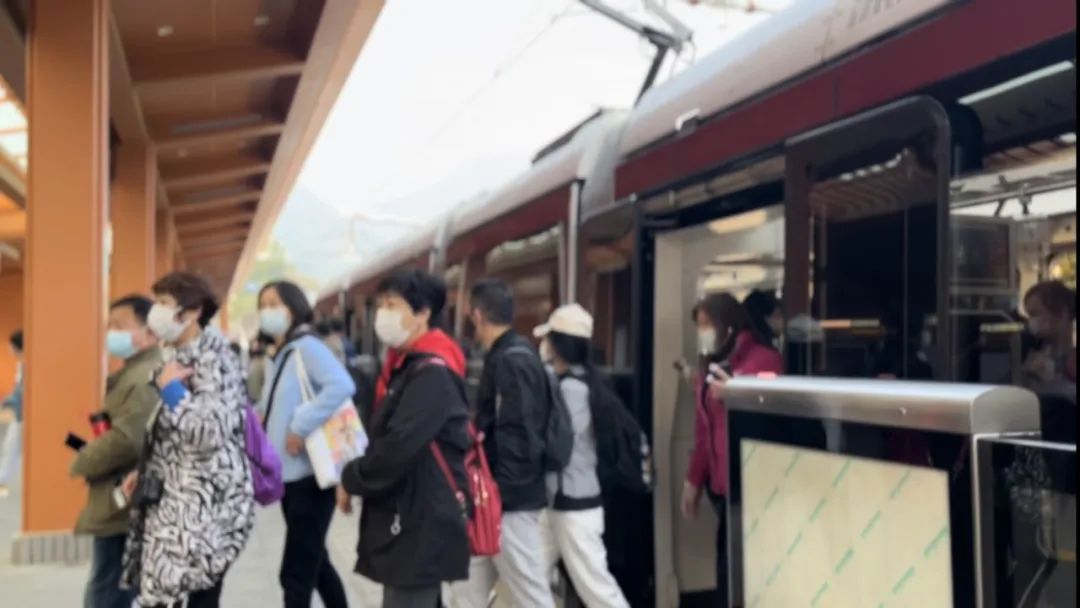
On October 25th, I made an appointment with my friend Lang Lang and took the Western Suburb Line to Xiangshan Biyun Temple. After getting off the bus and following the map navigation, I discovered that "it turns out that you don't need to go over Xiangshan Mountain to get to Biyun Temple." You just need to follow an alley called Meichang Street and reach the end of it, which is the temple. The mountain gate.
It was the red leaf season at this time, and the road to Xiangshan Park was really crowded. It made me reflexively smell the smell of grilled sausages that filled the park many years ago. It was also the only thing I had about Xiangshan Park. One of the memories.
Meichang Street on the way to Biyun Temple is very quiet. Occasionally I meet someone who seems to be a resident of the alley. Early in the morning, he wears pajamas, pajamas, slippers, and goes from his house to the canteen across the street to buy a pack of cigarettes. .
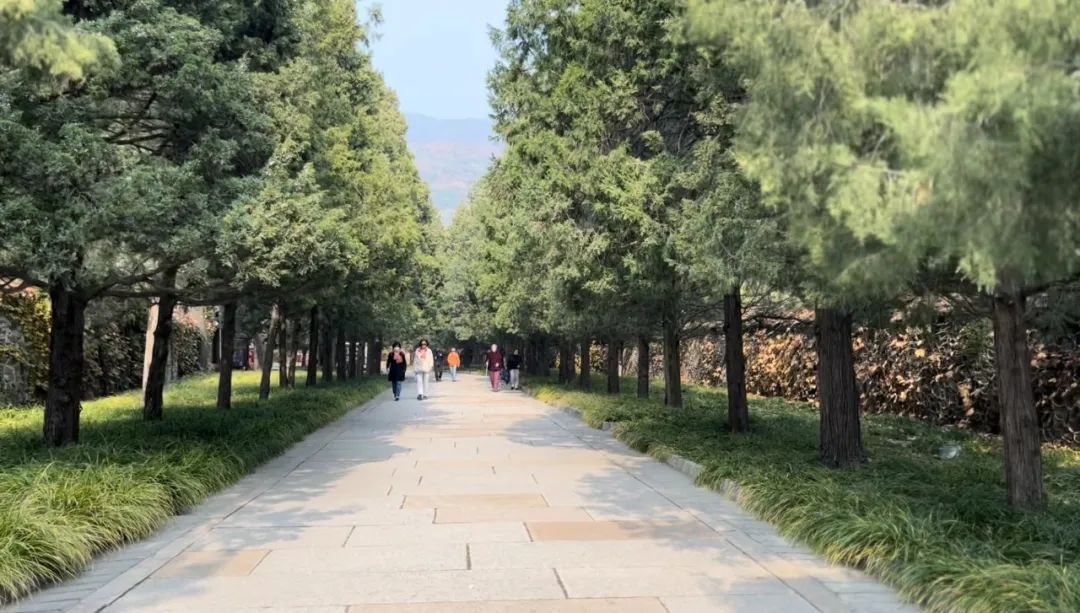
Entering Biyun Temple Mountain Gate, there is a queue of pines and cypresses that is common in ancient temples, guiding visitors all the way to the Mountain Gate Hall. It is still green, but the ivy on the wall behind them has completely entered autumn, with patches of red and yellow. Along the long green pine shrine, you can also look up at the rolling mountains, which are no longer "blue clouds" but show the colorful "liquid vermilion" color.
It is said that Biyun Temple is built on top of the mountain. Therefore, when we came here in such a season, Lang Lang and I hoped to be at the highest point in the temple, avoiding the bustling crowds, and enjoying the spectacular view of the red leaves of Xiangshan Mountain.
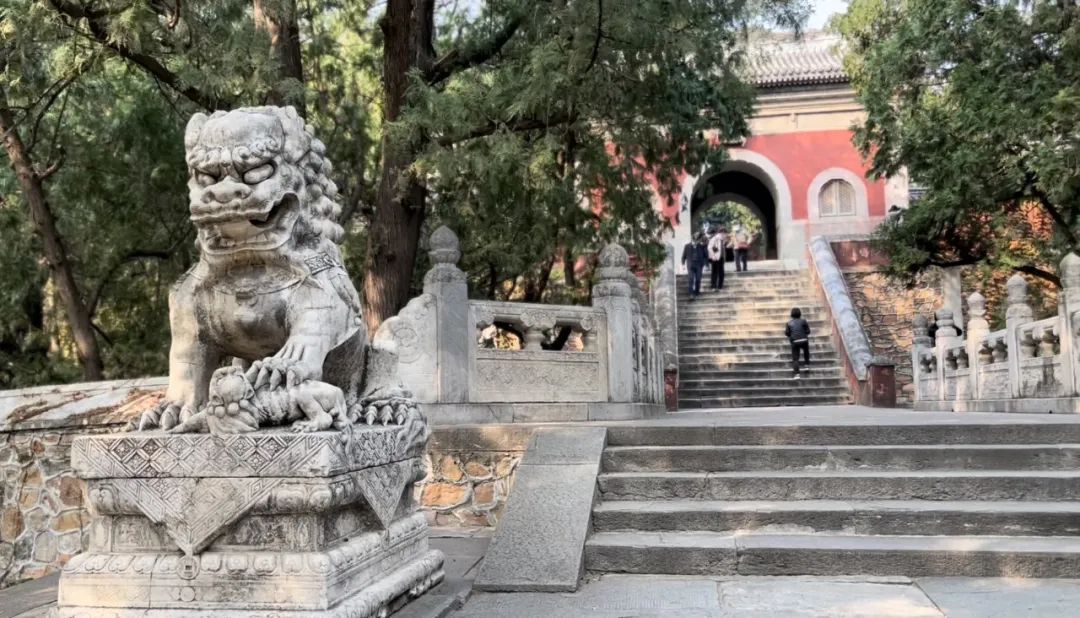
After exiting the pine and cypress shrine, I saw Shanmen Hall . First there is a pair of extremely beautifully carved stone lions . Anyone can tell at a glance that they are masterpieces of the ancients. Yes, it's from the Ming Dynasty. It is said that Wei Zhongxian ordered people to prepare it for his future resting place. Although Wei Zhongxian had a poor reputation, given his status as "nine thousand years old" at the time, he must have hired the best craftsmen to make the work at any cost.
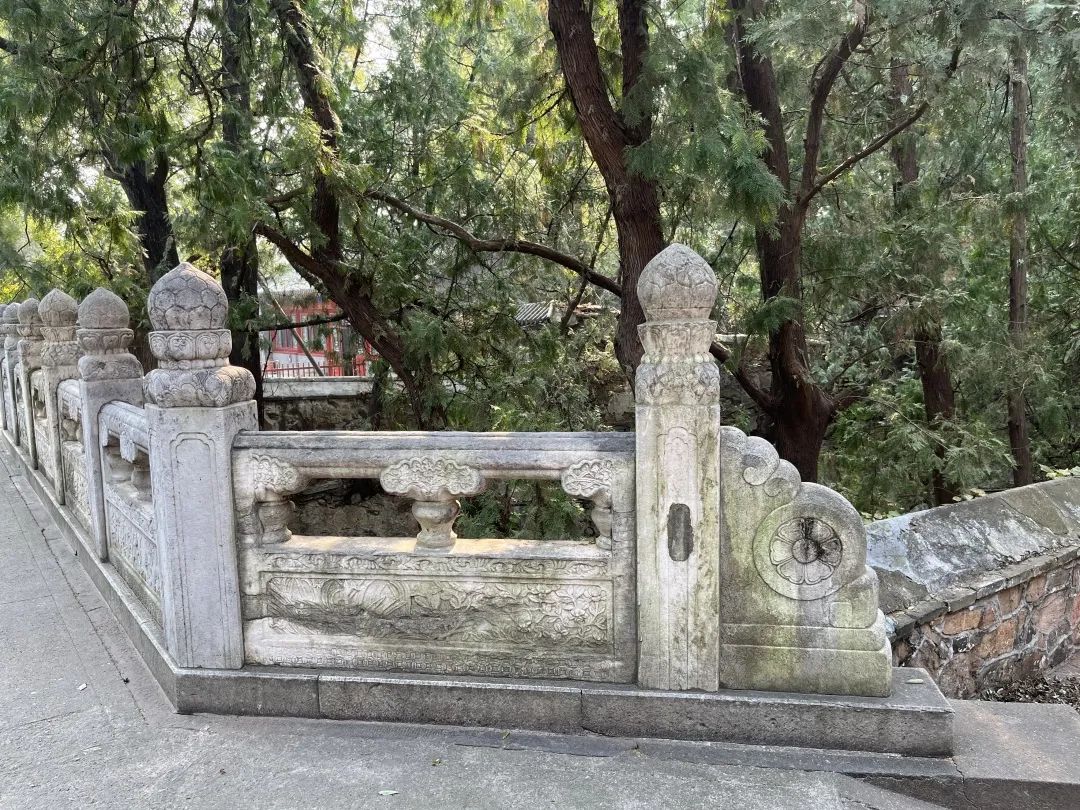
Behind the stone lion is a white marble bridge , which is mottled by wind, frost and moss, and has simple and exquisite carvings. Only the broken parts have been repaired in modern times. The stone bridge is erected over a deep ravine, with gurgling streams and green vegetation under the bridge.



After passing the Shanmen Hall, I looked up and saw red walls, steps, bamboos, old trees, deep courtyards... I suddenly thought, " Entering the ancient temple in the early morning/The first sun shines on the high forest/The winding path leads to the secluded place/The Zen room is deep with flowers and trees "The artistic conception is really great!
We lingered in this staggered courtyard for a long time.

Outside the courtyard wall of the Tianwang Hall , one can see an ancient ginkgo tree in its best season stretching out of the wall. There was a photographer holding a tripod, quietly thinking about shooting blockbusters from various angles.
In the Palace of the Heavenly King, the clay sculptures of the two generals Heng and Ha looked down angrily at the countless passers-by over the past few hundred years.
One level up is Maitreya Hall. The sculpture of Maitreya Buddha has a simple shape, smooth lines, and a sense of freehand brushwork, which is the artistic style of the Ming Dynasty. However, I didn’t take any photos, maybe I still felt religious awe in my heart.

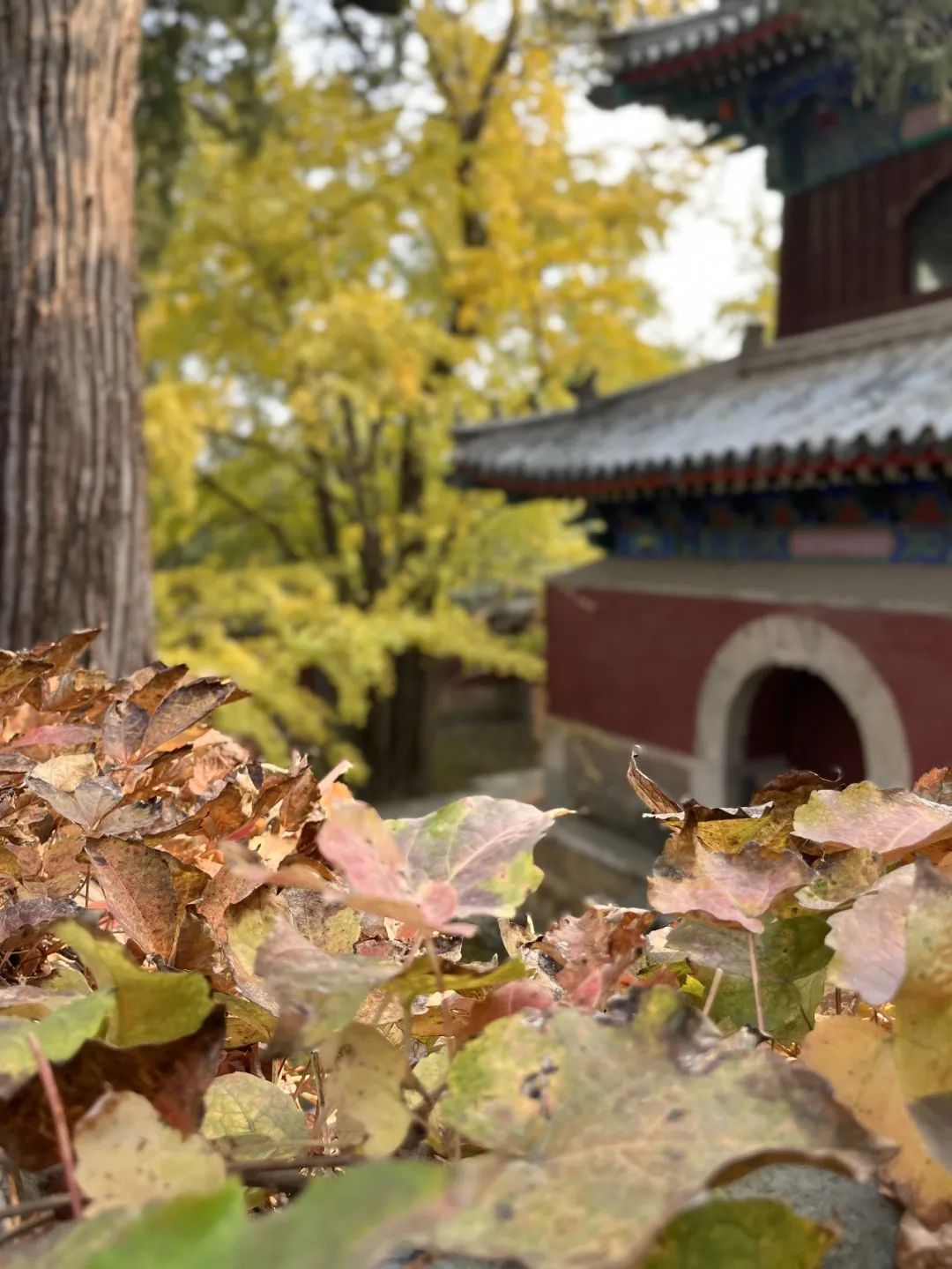
In the atrium of the Maitreya Hall, there are several ancient pines that are strong and beautiful, blocking out the sky and the sun. There is a ginkgo tree on each side, which is also hundreds of years old. The small fan-shaped leaves that spread out in the autumn are so golden and tender that they are so cute. , shining brightly in the sun and breeze, making people look at it for a long time and unable to bear to leave.
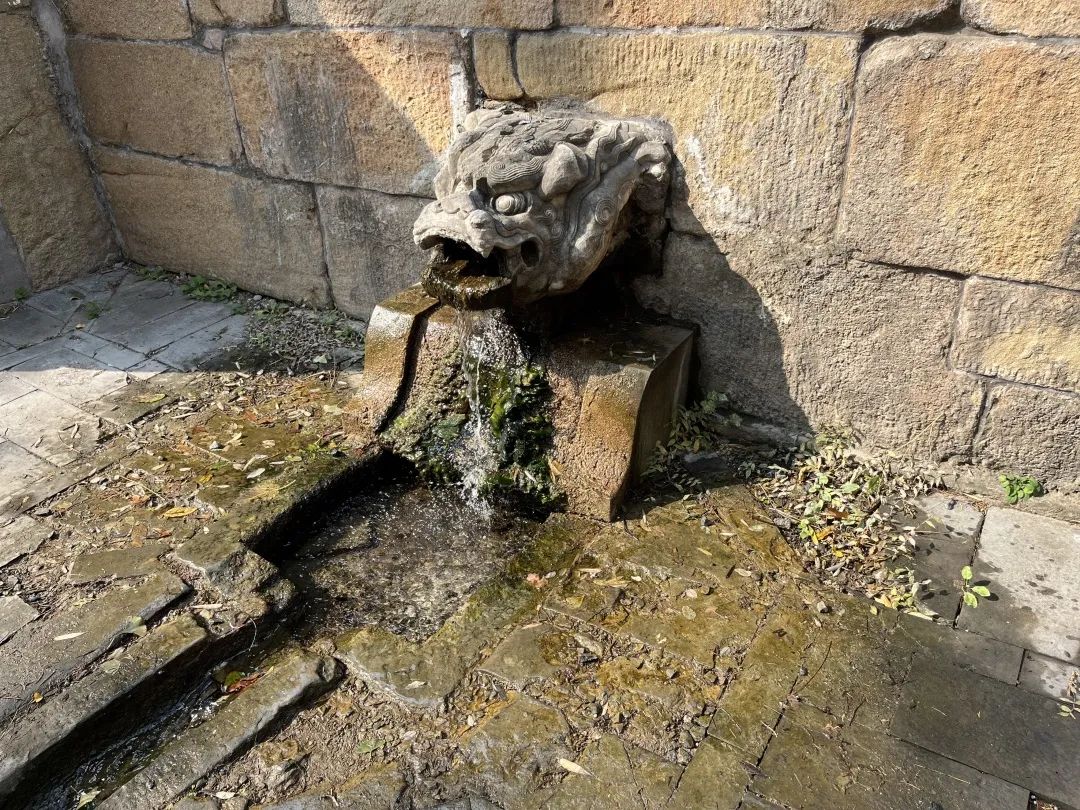
Most of the visitors were admiring the sparkling ginkgo trees, and few seemed to notice the gurgling springwater on the northwest side of the atrium. Perhaps, this spring is the most beautiful part of this temple. But this is just an exit, the more wonderful thing is still in Shuiquanyuan behind.
Continue to go up the stairs and enter Sakyamuni Hall . The east and west wings are lackluster. There are fish ponds on the left and right sides of the courtyard surrounded by white marble fences. The small red fish in them are as big as a finger. They are probably recently stocked, and there are no fat fish as described in the books of old literati. The water is also a bit turbid. Maybe the mountain springs here are no longer natural springs, and their sources have long since dried up.
The next floor up is the Bodhisattva Hall , and in the courtyard there is Qianlong Emperor Stele Pavilion , which probably records the renovation of this temple that started in the Yuan Dynasty during the Qianlong period. There may also be stories about the addition of the King Kong Throne Tower, the Palace of Water Spring, and the Luohan Hall. There may also be poems written by Emperor Qianlong while listening to the spring at Biyun Temple - this is my guess. When we modern people visit ancient monuments, it seems that we no longer have the patience to carefully identify the handwriting on the inscriptions. This is not a good habit. Since you are visiting ancient times, you should be more careful.
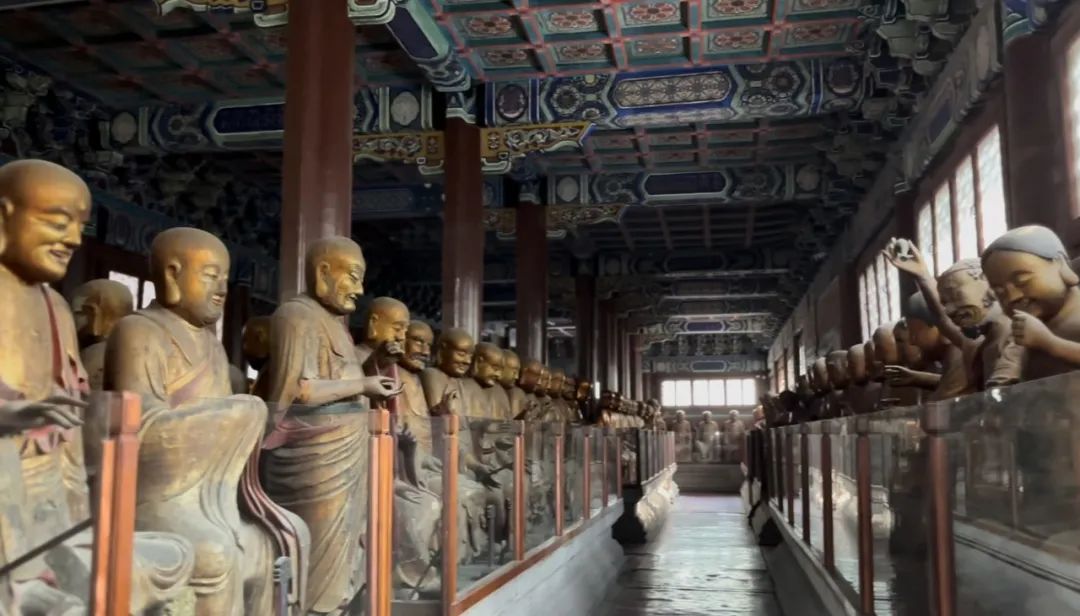

There is a door on the south side of the Bodhisattva Hall courtyard, which leads to the Luohan Hall across the south courtyard of the temple . It was built in the 13th year of Qianlong's reign based on the Luohan Hall of Jingci Temple in Hangzhou. However, the architectural form is a fusion of Chinese and Tibetan. The plane is in the shape of "field". There are 508 Arhats in the "field" in sequence. Arranged in a "mouth".
No photography allowed inside. But... I'm sorry, I took it. Because it's so beautiful! I think it is not inferior to Sanjusangen-do in Kyoto! Each Arhat is different and lifelike. They are made of wood and gold paint, and are arranged in rows. They are very beautiful!
Generally, every temple has some unique ways of praying to the gods, whether it is something that cannot be answered by science or something that has been given to it by people over time, such as praying for children, wealth, marriage, and health. Counting Arhats , count the one who is your age, and observe his behavior, expression, and face, as well as the things he is in charge of, to understand your fortune for the year. I have always stayed away from fortune-telling, but this time I was interested in trying it, so I asked the uncle who was watching the hall, and counted. When I counted one, I saw his posture and expression, grinning, and looked relaxed and happy. The one counted by the waves danced and was very cute. Then we carefully observed the arhats, and it seemed that all of them had pleasant postures. In this way, in fact, anyone can calculate a good fortune. But if you interpret the lot carefully, it may be that "everything has its two sides."

Finally coming to the main destination of my trip! Shuiquanyuan - a group of Qing Dynasty royal gardens located in the north courtyard of Biyun Temple, the Tingquan Villa of Emperor Qianlong.
According to specifications, the gardens of this group of affiliated temples are approximately five courtyards, with spaces naturally divided by pedestals, stacked stones, and ancient trees. The garden stretches from east to west, surrounded by mountains and rivers, dotted with flowers and trees, pavilions, corridors and pavilions. It has continued since more than 200 years ago and has experienced many changes, but still retains some ancient charm.

In fact, when I walked into Shuiquanyuan from the side door in front of Zhongshan Hall, I was a little disappointed. The scene was as ordinary as the faculty and staff family area on campus. Go east past the January Cave Gate, follow the stone path, and turn in front of Hanqingzhai, where you will see a stacked stone pool, which can be regarded as a garden scene. Follow the direction of the water spring and continue eastward, exiting the Moon Cave Gate in front of Hanbizhai. When you look back, a stunning "scenic spot" appears... the gorgeous golden autumn, just like this, embedded in a circular "picture frame", suddenly makes your eyes dazzle. Found the landing spot!
This is a kind of "Internet celebrity" beauty, with a certain meaning of human behavioral psychology. It can always catch your eyes at once, and it is easy to make videos and spread. If you don’t believe it, you can open Xiaohongshu or Dianping and search for “Biyun Temple”. There is a high probability that this spot is the “first camera” to check in for autumn viewing at Biyun Temple.

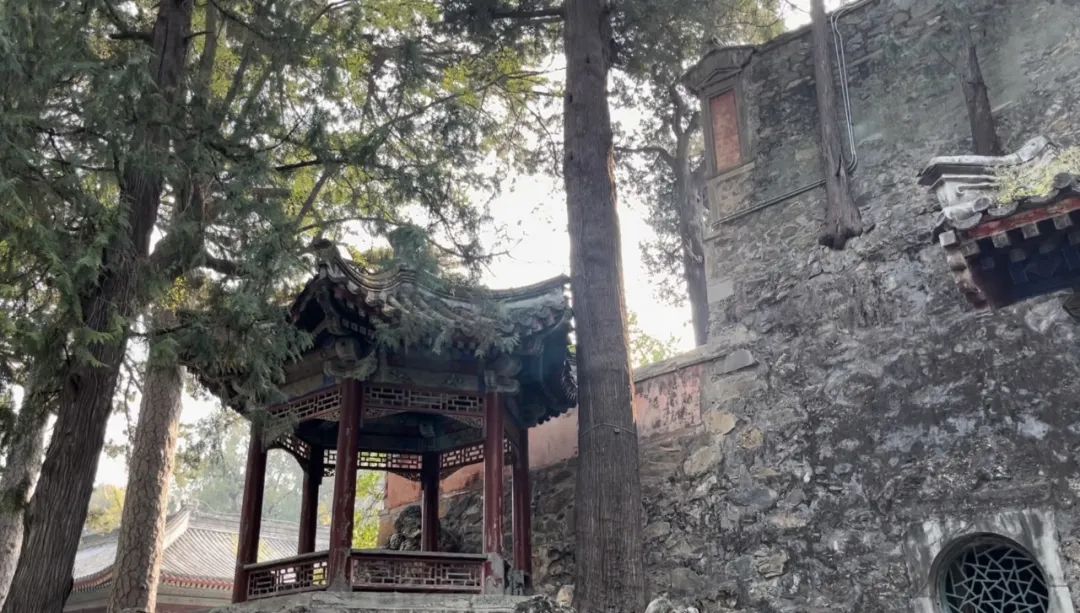


The essence of Shuiquanyuan is actually at the west end of this group of courtyards.
It is leaning against a cliff, with canopies of ancient trees, pavilions, stacks of rocks and mountains, and spring water gurgling from the cracks in the rocks. It is quiet and beautiful. I think this is probably the most beautiful temple garden I have ever visited in Beijing.
Unfortunately, it didn't turn out stunningly. Its beauty is the feeling you feel when you are walking in it. The scenery changes with each step, the vision of pitching up and down, the misty rosin that permeates the air, the sound of gurgling water springs, and the occasional birds flying through the woods above. The water turns into air, which makes people feel the deep poetry of the courtyard, quiet, quiet. ...an indescribable beauty.
This is just the tip of the iceberg of the ancient imperial family, and it is the remaining tip. We will never be able to empathize with them.
What is even more regrettable is that we know that there is such a life, such a life, such beauty, such beauty... And we only have this life, and we can only stand in this life to experience it.
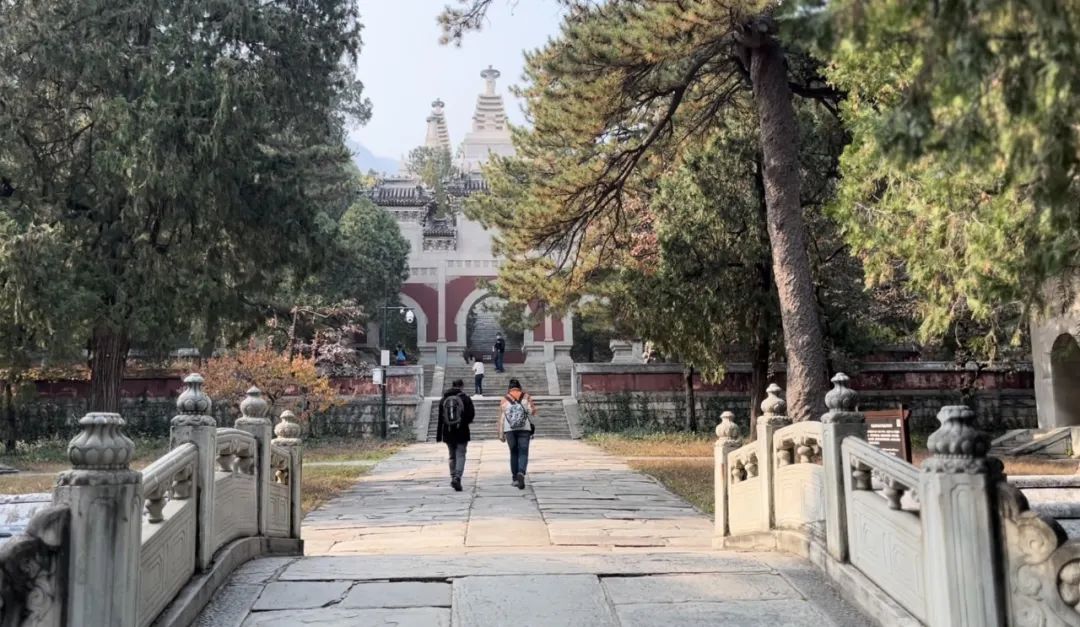
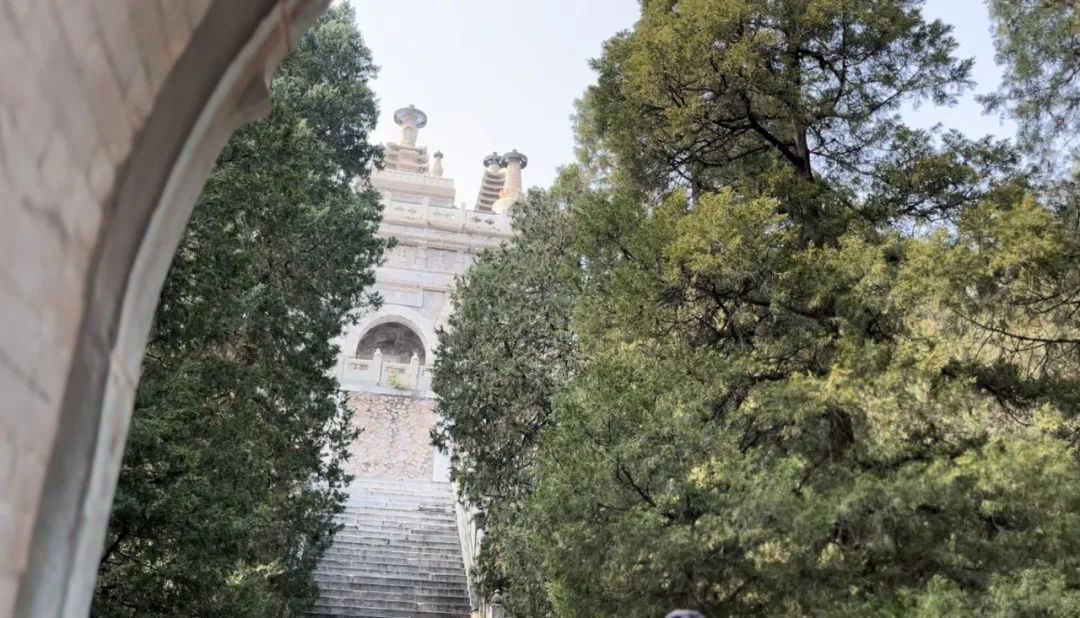
The last platform of the entire Biyun Temple is the Vajra Throne Tower that can be seen across the forest from Xiangshan Park. It was built in the 13th year of Qianlong's reign. It looks very similar to the Vajra Throne Pagoda of the Five Pagoda Temple (Zhenjue Temple) outside Xizhimen, Beijing. Of course, their sponsors were the same Emperor Qianlong. However, Biyun Temple has seven stone pagodas on the throne, including a house-shaped square pagoda, a round pagoda, and five thirteen-story square pagodas with dense eaves - a large pagoda in the center and a small pagoda at each corner. . This is a special variation of the mandala. However, our current visitors can no longer climb the tower. Looking at the Xishan travel notes written by Ji Xianlin and other gentlemen, as well as the black and white photos left by photography enthusiasts at that time, we can see that the throne and the seven towers above are covered with large and small Buddha statues, heavenly kings, dragons, phoenixes, lions, elephants, cloud patterns, etc. Exquisite relief. At this point, the visit to Biyun Temple comes to an end. We originally expected to see the red leaves of Fragrant Mountain from the highest point in the temple, but in the courtyard of the Vajra Throne Pagoda where we were standing, long pines covered the sky. The legendary spot where you can overlook the rolling mountains and endless plains is actually on the Vajra Throne Tower... Therefore, if you want to see the red leaves all over the mountains and plains, you’d better go to Xiangshan Park. Fortunately, the restoration project of Xiangshan Temple has been completed. Even if it is not for the red leaves, it is still worth visiting Xiangshan again. Because the location of Xiangshan Temple is the core of Tanshuiyuan, one of the eight major wateryards in the Xishan Mountain of Jin Zhangzong, and Jingyi Garden, the royal garden of the Qing Dynasty.
